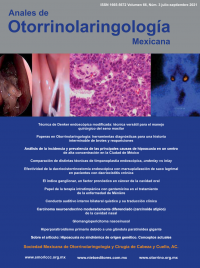
Modified endoscopic Denker approach: Versatile technique in surgical management of the maxillary sinus.
An Orl Mex. 2021; 66 (3): 175-181. https://doi.org/10.24245/aorl.v66i3.4533
Sandra Yadmina Bravo-Arteaga,1,2 Cesar Alfonso Gutiérrez-Espinosa,2 José Rosmal Cortés-Ponce1,2
1 Facultad Mexicana de Medicina, Universidad La Salle, Ciudad de México, México.
2 Servicio de Otorrinolaringología y Cirugía de Cabeza y Cuello, Hospital Regional General Ignacio Zaragoza ISSSTE, Ciudad de México, México.
Resumen
ANTECEDENTES: Debido a la disposición anatómica del seno maxilar, resulta difícil abordarlo con endoscopia nasal cuando aloja enfemedad en su porción anteroinferior o posterolateral. La técnica de Denker ofrece total visualización de las paredes del seno maxilar, sin requerir un abordaje sublabial o transeptal.
OBJETIVOS: Determinar las complicaciones asociadas con el procedimiento, cantidad de sangrado, tiempo quirúrgico y recuperación. Exponer las modificaciones realizadas a la técnica para su uso más allá del tratamiento del papiloma nasal.
MATERIALES Y MÉTODOS: Estudio retrospectivo y descriptivo que incluyó pacientes tratados de junio de 2015 a abril de 2019, todos con daño de las paredes del seno maxilar, la cavidad nasal y algunos hacia la fosa infratemporal.
RESULTADOS: Se incluyeron 14 pacientes. Se obtuvo exposición completa de la lesión, con media de tiempo quirúrgico de 3.1 horas y 154 mL de sangrado. Un paciente tuvo hipoestesia malar. Ningún paciente tuvo retracción alar y a la fecha 12/14 pacientes se encuentran sin recidiva.
CONCLUSIONES: Con la técnica Denker endoscópica se obtuvo adecuado acceso a los recesos anterolaterales y posteroinferiores del seno maxilar. Se utilizó exitosamente para el tratamiento de enfermedad infecciosa, inflamatoria o tumoral, distintas al papiloma nasal.
PALABRAS CLAVE: Seno maxilar; endoscopia nasal; técnica endoscópica.
Abstract
BACKGROUND: Due to the anatomical disposition of the maxillary sinus, it is difficult to approach it by nasal endoscopy when it has damage in its anteroinferior or posterolateral recess. Denker endoscopic technique offers full visualization of the maxillary sinus walls, without requiring sublabial or transeptal approaches.
OBJECTIVES: To determine the complications associated to the procedure, bleeding amount, surgical time and recovery. To present the modifications made to the technique to use it beyond the treatment of nasal papilloma.
MATERIALS AND METHODS: A retrospective and descriptive study with patients treated from June 2015 to April 2019. All with involvement of maxillary sinus walls, nasal cavity and some towards the infratemporal fossa.
RESULTS: There were included 14 patients. Complete exposure of the lesion was obtained, with a mean surgical time of 3.1 hr and 154 cc of bleeding. One patient presented malar hypoesthesia. No patient had alar retraction, and to date 12/14 are without recurrence.
CONCLUSIONS: With the Denker endoscopic technique, adequate access was obtained to the anterolateral and posteroinferior recesses of the maxillary sinus. It was successfully used for the treatment of neoplasms, infectious or inflammatory diseases, others than nasal papilloma.
KEYWORDS: Maxillary sinus; Nasal endoscopy; Endoscopic technique.
Recibido: 16 de julio 2020
Aceptado: 3 de junio 2021
Este artículo debe citarse como: Bravo-Arteaga SY, Gutiérrez-Espinosa CA, Cortés-Ponce JR. Técnica de Denker endoscópica modificada: técnica versátil para el manejo quirúrgico del seno maxilar. An Orl Mex. 2021; 66 (3): 175-181.

